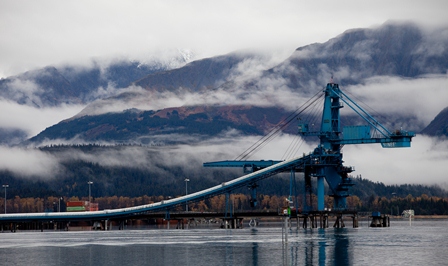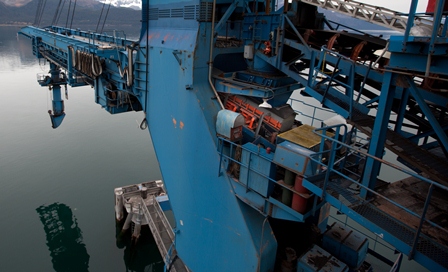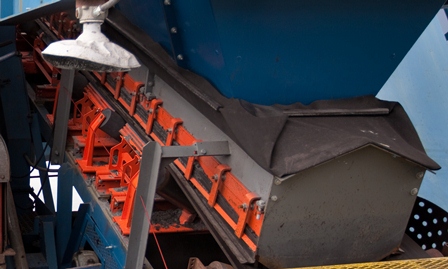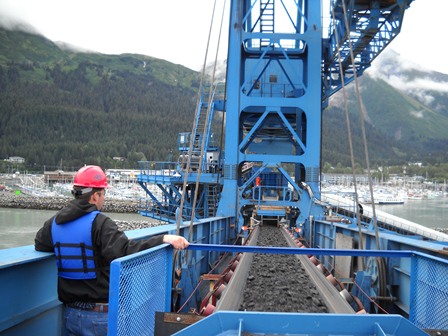“New Architecture” conveyor load zone helps Alaska coal terminal reduce dust while increasing throughput
Published: August 2nd 2016

The Port of Seward has completed a conveyor system upgrade for its coal handling operations that has raised throughput an estimated 20%, allowing Alaska’s largest coal producer to better compete for international customers. By installing the new EVO® Conveyor Load Zone from Martin Engineering, the terminal has increased the average load rate for the entire ship-loading process from 700 mt/h to 858 mt/h. The terminal has gone from an absolute maximum of 18,000 mt/d with dry coal and optimal loading conditions, to more than 20,000 mt/d on average -- including operations in poor weather and less than ideal operating conditions.
With throughput increased, ship-loading times are being reduced, driving down costs and making the exported coal more affordable to overseas customers. “Basically, we should be able to knock one day off our loading time for each ship,” observed Steve Denton, VP of Business Development for Usibelli Coal Mines.
“Over the course of a million tons per year, that’s a major savings for our customers, as they’ll be able to enjoy better FOB prices. It also saves us tremendously on the cost of ship demurrage, which helps us to pay for the cost of the conveyor investment,” Denton said.
Port a Critical Link

Since 1985, the Port of Seward has shipped over 16 million metric tons (mmt) of coal, all of it originating at the Usibelli mine 400 miles to the north, which currently exports more than 45% of its annual production. UCM and its affiliate Aurora Energy Services, LLC (operator of the Seward coal terminal) have no doubt that the port plays a key role in their future. With one of Alaska’s few year-round ice-free harbors, Seward is also the southern terminus of the state-owned Alaska Railroad, and offers terminal facilities -- owned by the railroad and operated by AES -- with the ship-loading resources to feed the expanding international export market.
A major obstacle to expansion was the port facility’s aging infrastructure, which had seen few improvements prior to 1999. Upgrades began that year when Alaska Railroad purchased the terminal, but despite best efforts, by 2008 the facility had become a logistical bottleneck, and with its occasional dust clouds, also a source of complaint.
The Issues
One of the worst problems was the ship-loader itself. With a view to expanding Usibelli’s export market-share, AES began taking steps to increase throughput at the Port facility, but initial efforts to reach 2,000 mt/h proved almost entirely unsuccessful. “Working with what we had, we could only reach 600-700 mt/h,” said AES Terminal General Foreman Vic Stoltz. “We made some improvements and got up to a steady run rate of 750 mt/h. But as we did, there were still some major issues with coal backing up in the chute.”
Even as some gains were realized, AES found that with higher-speed operation, dust became an increasing problem. Constructed in a less environmentally-sensitive era, the ship loader design was not adequate to contain fugitive material, allowing airborne coal dust to generate negative attention and threaten community relations.
Combining Solutions
The need to increase throughput capacity at Seward while protecting the region’s air quality and natural splendor led AES to investigate new conveyor technology from Martin Engineering. AES first sent bucket-sized samples of the typical conveyed material to Martin’s R&D center in Illinois. After testing the coal to determine its flow properties, the company’s specialists used Discrete Element Method modeling to design a chute capable of properly handling the coal. “When we got back the computer models, we saw that we were able to pass 1500 mt/h and still control dust, all while keeping within our capital budget,” said Stoltz.
A few months later, Martin Engineering followed up with an environmental audit while AES was loading a ship, suggesting improvements to the process. AES decided to implement several significant modifications, including a new EVO® equipped ship loading chute. “We knew that we had to do something about the environmental and production issues that were being caused by this one chute,” said Stoltz. “When our management realized that we could increase through-put, increase safety and reduce our environmental impact all at once, they were completely in favor of implementing the suggested upgrades.”
A New Conveyor Architecture
The new transfer point makes use of Martin® Inertial Flow™ Transfer Technology, and the entire chute is custom-engineered and modeled in 3-D to provide the optimum design for the material and flow rate required. The “hood” controls the flow of material from the discharging conveyor, maintaining a coherent material stream and minimizing induced air. A smooth loading chute (spoon) places the stream of coal onto the ship loader’s boom conveyor at the proper speed and angle with minimal impact, reducing material degradation, belt abrasion and the expulsion of airborne dust. By controlling the flow of material, this engineered transfer chute helps eliminate blockages, shape the load and contain fugitive material.
Martin Engineering also supplied other redesigned components to contain material and improve serviceability. Belt support cradles were installed under the drop chute to absorb impact and stabilize the belt line and prevent spillage. AES also mounted EVO® External Wear Liner on the load zone’s existing skirt board for improved sealing. Because it is attached from the outside, it is easier to install, inspect and adjust than conventional seals, without requiring confined space entry.
Pre-engineered modular chute wall sections simplify the design and construction of the transfer point stilling zone to manage airflow and control dust. At the exit end of the load zone structure, dust curtains act as baffles to slow air movement and allow airborne dust to settle back onto the conveyor.
Designed to adapt to the unique needs of a specific facility, the EVO® conveyor structure has made the new transfer point easy to install. Martin shipped everything to Seward by container, with all components organized, numbered and labeled. “We were able to easily figure out where everything needed to go,” said Stoltz. Developed to connect simply and quickly to an existing structure, the EVO® Load Zone took only five days to install and put into service.

Results
The first thing the AES crew noticed was an improved material load rate. During the initial shakedown run, operators noted the conveyors weigh scale pegged at 100%, but the belt didn’t shut down. The old system peaked at 1000 mt/h (including ship and hatch moves), but with new components in place, the system hits peaks of 1500 mt/h.
As the AES crews have grown familiar with the new equipment, they are loading even faster. “Loading at the maximum run-rate is a whole new ballgame for our operators,” Stoltz added. “We don’t have slowdowns due to the chute clogging up, which previously was a constant battle.”
Immediately after the first ship was loaded, UCM went through the numbers in the vessel’s Statement-of-Fact. Excluding crew time, the company found that the loading rate with the EVO® System was 21,000 mt/d, a record for the terminal and a significant accomplishment.
Equally important, following the system’s initial run, the ship loading area was virtually free of fugitive material and dust build-up, allowing AES crews to reduce their cleanup time from days to just hours. “After the first boat, all we needed was a dustbin,” said Stoltz. “The clean-up time has been reduced by over 40 man-hours per shipload.”
Reducing Risk
To AES, the environmental and worker safety benefits of Martin Engineering’s upgrades have been just as important as the production advantages. “Faster loading times help manage our risk, from both the environmental and the safety perspective,” commented Bartly Coiley, AES Manager of Environmental Affairs.
“Poor weather conditions can and will conspire to generate more dust, so from an environmental standpoint, the faster you’re able to load, the less risk you have that weather conditions will impact your loading cycle,” said Coiley. “The longer it takes to load a ship, the greater the chances of creating dust.”
Service is critical to a conveyor’s reliability, and therefore a key to productivity. Situated 90 feet above the waters of Resurrection Bay, the ship loading area is a very demanding environment for maintenance personnel, but the EVO® load zone is designed for ease of service and maintenance.
With most components externally mounted, workers can remove and service most of the system from outside the conveyor structure, without having to access confined spaces. “There are fewer safety risks,” said Stoltz. “The access is really easy, and there are only a couple of occasional adjustments the operator needs to make.”
“Martin Engineering has gone way beyond what they had to do, making sure we were more than satisfied,” Stoltz concluded. “When we first fired up the belts, the systems performed just as they predicted. Better, in fact. With these upgrades, we’re earning our money back every time we start the system up.”
Improved Loading is Key to Future Growth
Having an outlet to the ocean is vital for Usibelli. Not only is the export market consuming virtually half of what the mine currently produces, the Port of Seward is the mine’s growth gateway to the future. “Overseas, the market is virtually limitless, and there are signs that Alaska is being recognized as an international supplier,” said Denton.

Usibelli coal is sought primarily for its ultra-low sulfur content. “Alaska has a vast, virtually untapped coal resource,” he explained. “We’re stable and despite our winters, we don’t have the horrendous weather issues that some mines have faced. Our customers see that we have large reserves, that we’re a stable company and that we’re able to ship predictably.”
And now they can move ships in and out of port even faster. “The work that Martin Engineering did eliminated a chronic bottleneck for us. There were many things we were doing to increase our throughput, but it was impossible to realize the full benefits until we cleaned up our loading operation with the installation of the new EVO® hood and spoon transfer chute.”
Clean Coal-Handling Technology
The improved coal handling system is helping the Seward Coal Terminal prepare for further growth. The new conveyor load zone on the terminal’s ship loader has eliminated most environmental issues, which has been good for the public image of coal in a town that sees a plethora of tourists each year.
“Because our location is right next to the cruise ship dock, our facility is almost a tourist attraction in and of itself,” according to Stoltz. “We get lots of questions about coal. Folks tell us that they always thought coal handling was a big mess, but now they can see it doesn’t have to be that way. After installing the EVO® System, the cruise ship passengers don’t see any dust and even the ship crews couldn’t tell coal was being loaded.”